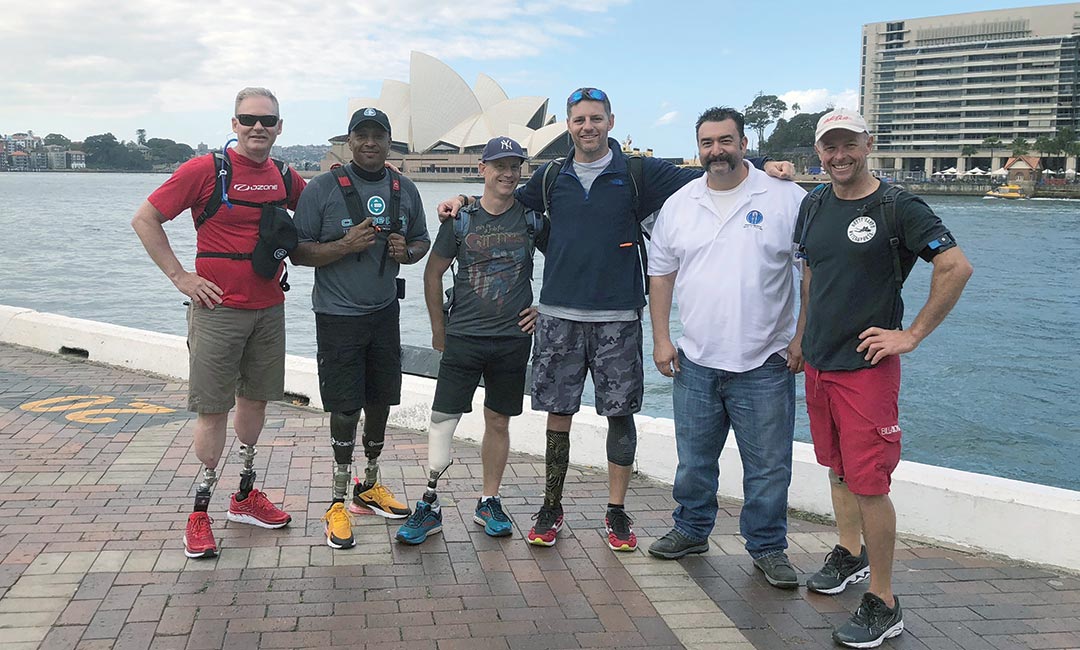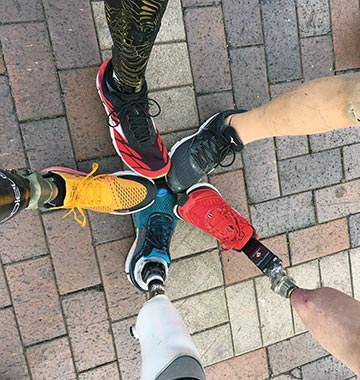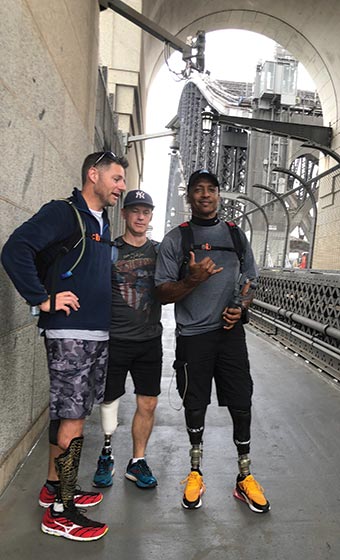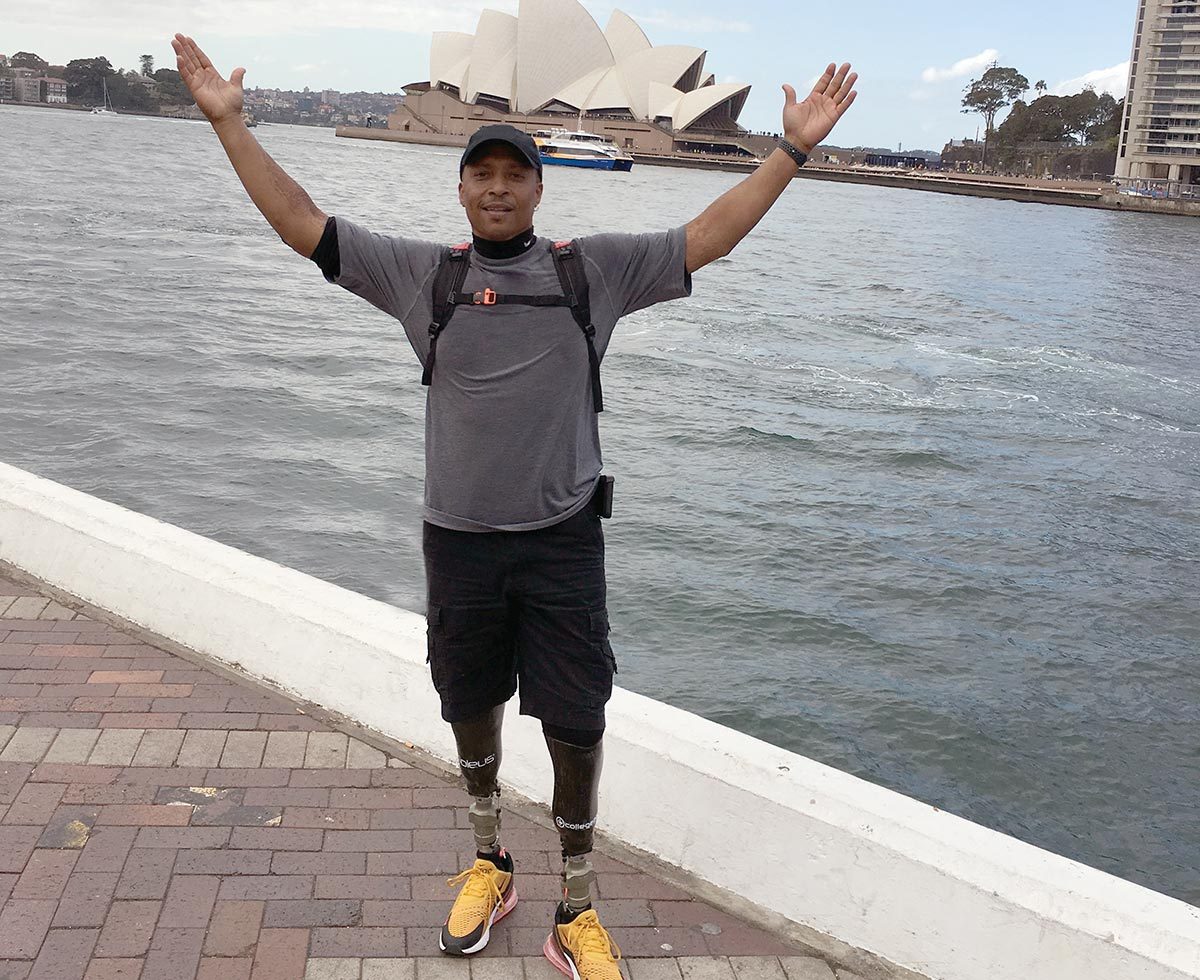Shared from inMotion | Volume 28, Issue 5 | September/October 2018, Page 26
by Laura Simpson | All photos courtesy of AmpUtek.
The trek began in 300 B.C. in Capua, Italy – the year of the first documented prosthetic leg. Since then, there have been hundreds of medical and technological advancements to help those living with limb loss. From the exploration of metals and fabrics to the study of anatomy and physics, people have dedicated their lives to finding prosthetic solutions that foster the best quality of life.
Fast forward to 2018. Socket technology and osseointegration have become the leading methods for attaching prosthetic limbs. On May 24 of this year, a small group of amputees met up in Sydney, Australia with the mission of walking 50 miles in three days to study, compare, and hopefully improve these options. This event, the Amp Trek, is part of a historical process, as it reflects the ongoing strength, courage, passion and mutual support of both the medical and amputee communities.
Understanding Osseointegration
The mastermind behind the Amp Trek is Fred Hernandez, U.S. operations manager for Osseointegration International, Inc. and president of AmpUtek. Fred has been an above-knee amputee for 33 years, and he became the first American to undergo osseointegration surgery in Australia in 2013. Osseointegration is the direct contact between a living bone and a synthetic implant. This implant is often titanium-based, and it is connected to an external prosthesis through an opening in the residual limb. Fred’s orthopedic surgeon, Dr. Munjed Al Muderis, uses the most anatomically correct implants to yield natural, comfortable results. Fred’s goal with the Amp Trek is to raise awareness for osseointegration and gather real-world data comparing it to socket technology.
“Typically, what we see in the O&P community are studies based on some very basic walking tests in a controlled environment,” Fred explains. “I don’t believe those tests provide a realistic view of the pros and cons surrounding either technology. The only way to truly show the pros and cons of the systems is to put both technologies through real-world scenarios over an extended period of time and document any issues participants experience.”
To make this trek possible, Fred collaborated with College Park Industries, ST&G, Amputees Association of NSW, and the group who performed his surgery: the Osseointegration Group of Australia. The Amp Trek participants included: Reggie Showers, Chris Bruha, Gareth Williams, Darrel Sparke, Jared McCoy, Sam Bell and Mitch Grant, with support from Marian Foulcher Wulf and William Lu.

(Left to Right) Chris Bruha, Reggie Showers, Darrel Sparke, Gareth Williams, Fred Hernandez, and Sam Bell in front of the Sydney Opera House after sharing the Amp Trek mission with the locals.
“Osseointegration offered me the ability to free myself from the socket and all the issues that came with it.”
While osseointegration was initially used in bone and joint replacement procedures, it has proven to be a promising solution for amputees who struggle with socket technology. This method provides direct contact from the bone to the ground, which improves control, stability and energy exertion. This procedure is rarely performed in the U.S. Like all medical breakthroughs, osseointegration has its share of skeptics.
“All systems are not the same, and the technology has come a long way since its advent back in 1990,” Fred says. “Most of what I see out there is clouded in misinformation or fear, which is primarily based on the early complications and at times perpetrated by those in the O&P and medical community.”
“Osseointegration offered me the ability to free myself from the socket and all the issues that came with it,” Fred adds. “For me, it was an easy decision to make and a form of technology that I had been waiting for since I became an amputee back in 1985.”
Trekking in a Socket
While three of the Amp Trek participants were osseointegration patients, the other four wore traditional sockets. Reggie Showers, patient advocate for College Park Industries, has been a bilateral below-knee amputee for 40 years. In his sockets, he has become a world champion motorcycle racer, inspirational speaker, accomplished pilot, certified snowboard instructor, marathoner, and volunteer at community events year-round.

Sockets and suspension have to fit an amputee’s activity level while providing comfort and stability. Prosthetists know how to properly shape and suspend sockets for their patients, but some patients are harder to fit than others. Ill-fitting sockets and volume change can cause sores. When people are walking or exercising regularly, the sores don’t have time to heal and can lead to daily discomfort.
Reggie credits his success with sockets to preventive maintenance and consistent adjustment. Changes in pressure gradient and alignment can be addressed quickly with these techniques.
“I’ve been in numerous situations where I had to walk many miles under extreme circumstances, and my biggest take-away from all of them was the importance of self-preservation,” he says. “You have to be smart, conserve energy and minimize risk. The journey can be long and arduous, and you want to reduce the chance of failure by staying in the green and out of the red.”
Route and Finish Line
It’s not every day that you see a group of amputees walking down the street together on a mission. The participants trekked through neighborhoods, down city streets, across the Sydney Harbor Bridge, past the Sydney Opera House, and along the shore. The locals were curious and supportive, asking questions and giving high fives. Several people walked alongside the Amp Trekkers, while others asked to take photos with the group. According to the participants, the locals found their mission to be amazing and inspirational.
“You have to be smart, conserve energy and minimize risk. The journey can be long and arduous, and you want to reduce the chance of failure by staying in the green and out of the red.”
The Amp Trek Sydney began at Barrenjoey Beach on May 24 and ended 50 miles away at Dunningham Park on May 26. Upon reaching the finish line, the participants were greeted by a celebration and outpour of community support. Carmelo Pesce, mayor of Sutherland Shire in the southern region of Sydney, recognized the importance of the Amp Trek in the community and attended the finish line event. The participants reported feeling an overwhelming sense of relief and accomplishment.
Chris Bruha, bilateral below-knee osseointegration patient, completed the Amp Trek just 10 months post-op. Although recovery times vary for everyone, Chris regained his high activity level and strength in less than one year. In preparation for the Amp Trek, he switched to Soleus feet from College Park and spent time training on his bike.
Each participant had varying levels of amputation and endurance. According to Reggie, “The Amp Trek is not a sprint. It’s more like a marathon. There is no hurry to get to the next waypoint. As long as we reach our destinations safely and document the performance issues along the way, it’s all good.”
“There is no hurry to get to the next waypoint. As long as we reach our destinations safely and document the performance issues along the way, it’s all good.”

Gareth Williams, Darrel Sparke and Reggie Showers take a quick break from trekking through crowds on the Sydney Harbor Bridge
The Big Picture
Limb loss is not an end point. It’s part of the trek. This trek goes through history and medicine, testing resilience and the human spirit along the way. This trek opposes fear, weakness and doubt with courage, strength and determination. Those living with limb loss are part of an incredible journey dating back to a time even before 300 B.C.
As Reggie says, “The Amp Trek experience gives hope to the new amputee who doesn’t know what to expect out of their new normal. No longer will they worry if they will be able to play ball with their kids or dance with their daughter at her wedding. Amp Trek lets the amputee community know that all things are possible, and you are limited only by your own disbelief.”
The Future of the Amp Trek
This event is the first of many. Fred and Reggie are in the early stages of organizing a larger trek in the U.S. for 2019. They learned lessons from the Amp Trek Sydney and have found ways to improve the event for next year to increase participation, support and data-gathering. Both socket wearers and osseo participants experienced their own unique set of issues. Participation in the 2019 Amp Trek will ensure more conclusive data. This event will continue celebrating the strength of the amputee community, prosthetic industry innovation, and groundbreaking medical advances in osseointegration.
“Our vision is to have this be an annual event at exotic locations all around the world,” Reggie says. “Can you imagine Amp Trek Dubai, Amp Trek Singapore, Amp Trek Tanzania? I can, and we’re going to make it happen.”
The successful blend of technology and humanity has laid the foundation for events like this. There will be new advancements, breakthroughs and success stories as the journey continues. Keep on trekking.
©2018 Amputee Coalition LLC | Amputee-coalition.org | 888-267-5669
Published in inMotion, Volume 28, Issue 5 | September/October 2018, Page 26



